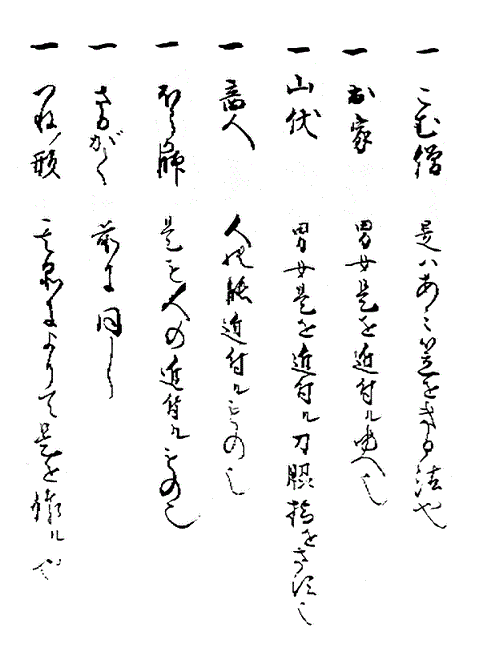|
Ninpiden
The ''Ninpiden'' (a.k.a. ''Shinobi Hiden'', or ''Legends of Ninja Secrets'') is an authentic ninjutsu manual written by Hattori Hanzō in 1560. It is regarded as one of the three key historical texts of ninjutsu, along with the ''Shōninki The ''Shōninki'' ( Japanese 正 忍 記) is a medieval ninja document from Kishū province. Written by Natori Masatake in 1681 it describes the espionage strategies of the shinobi from Kishū. Together with the Bansenshukai and Ninpiden it is ...'' and the '' Bansenshukai''. It was passed down in the Hattori family, and was considered a secret transmission; it was not shared with outsiders and even within the family, few had access to it. References Bibliography * Antony Cummins & Yoshie Minami, eds. & trans. ''The Secret Traditions of the Shinobi: Hattori Hanzo's Shinobi Hiden and Other Ninja Scrolls''. Berkeley, Calif.: Blue Snake Books, 2012. {{Martialart-stub Ninjutsu Martial arts manuals ... [...More Info...] [...Related Items...] OR: [Wikipedia] [Google] [Baidu] |
Shōninki
The ''Shōninki'' ( Japanese 正 忍 記) is a medieval ninja document from Kishū province. Written by Natori Masatake in 1681 it describes the espionage strategies of the shinobi from Kishū. Together with the Bansenshukai and Ninpiden it is one of three major extant writings of the ninja."Martial arts of the world: an encyclopedia, Volume 2: Ninjutsu", 2001, Thomas A. Green An original copy of the Shōninki is in the State Library of Tokyo. Contents The Shōninki is divided into Preface (Jo), three scrolls (Shomaki, Chumaki, Gemaki) and an epilogue (Okusho). In the preface, the author discusses the different types of spies and the principles of espionage. Mar 3, 2011, Metropolis magazine The first scroll addresses basic skills, such as disguise and concealment, house-breaking and i ... [...More Info...] [...Related Items...] OR: [Wikipedia] [Google] [Baidu] |
Ninjutsu
, sometimes used interchangeably with the modern term , is the martial art strategy and tactics of unconventional warfare, guerrilla warfare and espionage purportedly practised by the ninja. ''Ninjutsu'' was a separate discipline in some traditional Japanese schools, which integrated study of more conventional martial arts (''taijutsu'') along with ''shurikenjutsu'', ''kenjutsu'', ''sōjutsu'', '' bōjutsu'' and others. While there is an international martial arts organization representing several modern styles of ''ninjutsu'', the historical lineage of these styles is disputed. Some schools claim to be the only legitimate heir of the art, but ''ninjutsu'' is not centralized like modernized martial arts such as judo or karate. Togakure-ryū claims to be the oldest recorded form of ninjutsu, and claims to have survived past the 16th century. History Spying in Japan dates as far back as Prince Shōtoku (572–622). According to Shōninki, the first open usage of ''ninjutsu'' ... [...More Info...] [...Related Items...] OR: [Wikipedia] [Google] [Baidu] |
Hattori Hanzō
or ''Second Hanzō'', nicknamed , was a famous Ninja of the Sengoku era, who served the Tokugawa clan as a ninja, credited with saving the life of Tokugawa Ieyasu and then helping him to become the ruler of united Japan. He is often a subject of varied portrayal in modern popular culture. Hanzō was known as an expert tactician and a master of sword fighting. Early life Born the son of (first Hanzō), a minor samurai in the service of the Matsudaira (later Tokugawa) clan. Stephen Turnbull, ''Ninja AD 1460–1650'' (2003), p. 12Joel Levy, ''Ninja: The Shadow Warrior'' (2008), p. 157-158 His birth name is , and he became known as the ''Second Hanzō''. He would later earn the nickname because of the fearless tactics he displayed in his operations; this moniker also distinguished him from Watanabe Hanzo (Watanabe Moritsuna), who is nicknamed . Though Hanzō was born in Mikawa Province (now Iga-chō, Okazaki, Aichi), he often returned to Iga Province, home of the Hattori fami ... [...More Info...] [...Related Items...] OR: [Wikipedia] [Google] [Baidu] |
Ninjutsu
, sometimes used interchangeably with the modern term , is the martial art strategy and tactics of unconventional warfare, guerrilla warfare and espionage purportedly practised by the ninja. ''Ninjutsu'' was a separate discipline in some traditional Japanese schools, which integrated study of more conventional martial arts (''taijutsu'') along with ''shurikenjutsu'', ''kenjutsu'', ''sōjutsu'', '' bōjutsu'' and others. While there is an international martial arts organization representing several modern styles of ''ninjutsu'', the historical lineage of these styles is disputed. Some schools claim to be the only legitimate heir of the art, but ''ninjutsu'' is not centralized like modernized martial arts such as judo or karate. Togakure-ryū claims to be the oldest recorded form of ninjutsu, and claims to have survived past the 16th century. History Spying in Japan dates as far back as Prince Shōtoku (572–622). According to Shōninki, the first open usage of ''ninjutsu'' ... [...More Info...] [...Related Items...] OR: [Wikipedia] [Google] [Baidu] |
